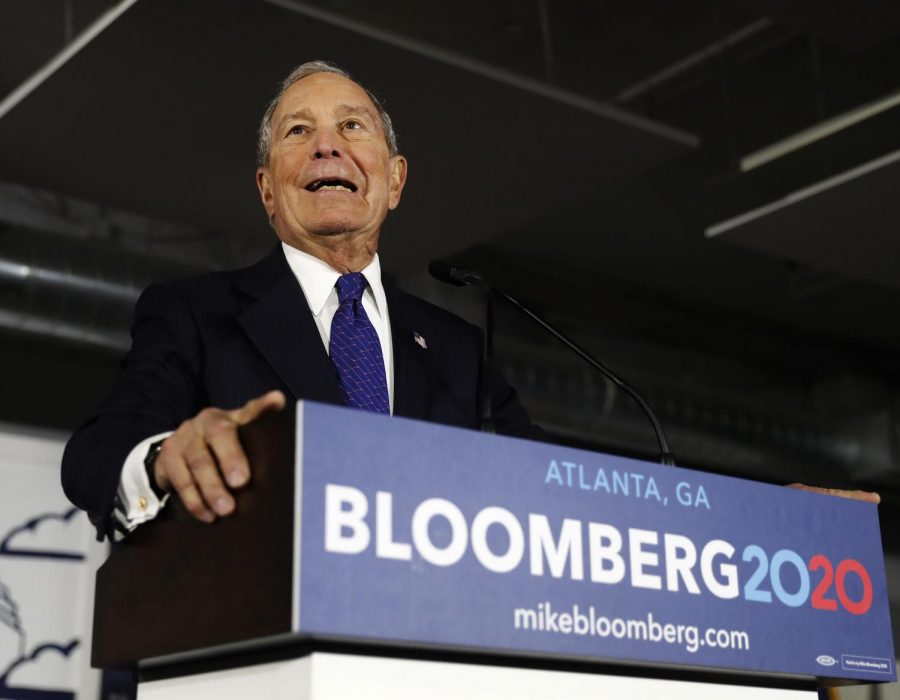The rise of Michael Bloomberg
Sports Editor Colin Horning discusses the rise of Michael Bloomberg’s campaign, despite being a late-comer to the 2020 race.
Feb 24, 2020
The 2020 presidential race is starting to heat up as primary season gets underway, and with it comes a greater idea of how the political picture will take shape. The first in the nation caucuses in Iowa is behind us, as well as the New Hampshire primary, which now leads us into South Carolina and, eventually, Super Tuesday on March 3. Following the first two contests, the picture among Democrats has Bernie Sanders leading the way as the likely nominee in the general election. But recently, we’ve seen another candidate start to pick up momentum and national attention: former New York City mayor Mike Bloomberg.
A late entry into the race, Bloomberg officially threw his hat into the ring back in November, almost an entire year after most of the Democratic candidates had announced their candidacy. Numerous candidates began running and dropped out prior to Bloomberg entering the race, as well as several of the nationally-televised Democratic debates coming and going with the former mayor sitting on the sidelines. However, none of this seems to really matter for the 78-year-old, as he has spearheaded an aggressive, nationwide spending campaign and organized a large campaign staff around the country that no other candidate in the race can even come close to matching. TV, radio, social media and practically every corner of the Internet have been flooded with Bloomberg ads, and he has pledged to spend up to $1 billion through election day even if he doesn’t wind up becoming the Democrat nominee, indicating that we will still be hearing from him (perhaps not directly) long after primary season is finished. His deep pockets and name recognition already made him a legitimate contender before entering the race, and now it’s starting to come into fruition.
I am by no means a Bloomberg supporter or advocate, but amongst the current field of Democrats, he seems to be the best shot they have at winning back the White House this year. He’s been branding himself as a “centrist” or “moderate,” which is more or less just political banter to appeal to Democratic or independent voters who have been put off by the far-left policies of the Democratic frontrunners. The role of the “centrist Democrat” has been filled by former Vice President Joe Biden, but his campaign appears to be losing any momentum it might have had, leaving the door open for the big-spending Bloomberg to take his place.
While Bloomberg’s name recognition and deep pockets make him a force in 2020, his baggage and lack of charisma will no doubt put people off. If the Democrats want to take back the White House in 2020, they’ll surely need to win back the midwestern and Rust Belt states that Trump won in 2016, like Michigan, Pennsylvania and Wisconsin. Bloomberg doesn’t really appeal too much to voters in this area however. As a wealthy, coastal elite who is on record implying that farming doesn’t take a lot of intelligence, he could very well lose a lot of voters in this region of the country.
Should he get the nomination, it will also be very likely that the Bernie voters will stay home, much like they did in 2016 when Hillary Clinton got the nod over the Vermont senator. Many Sanders supporters have been vocal about Bloomberg’s attempt to “buy the election” and many of them are strongly against the concept of money in politics corrupting the political system. The rift between the liberal Democrats and the Bernie Democrats will likely lead to a divided voting base come November, regardless if Bloomberg is the nominee or not. Chances are, many of the more moderate Democrats will stay home should Sanders win the nomination, because his policies might be too left-wing for the more traditional Democrats. Either way, the 2020 race will definitely be an interesting several months to come.









